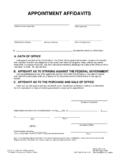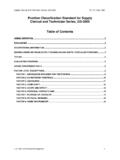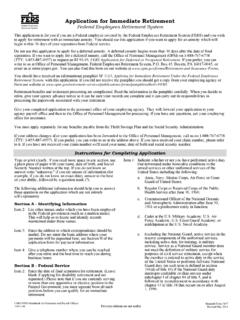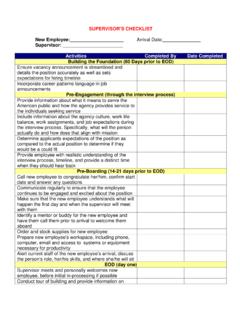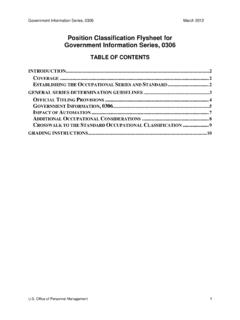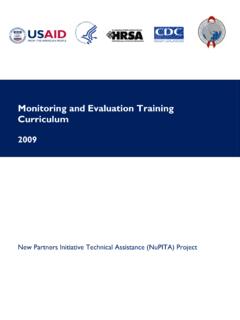Transcription of 360-Degree Assessment - OPM.gov
1 United StatesPerformanceOffice ofManagementPersonnel and IncentiveManagementAwards Division360-DegreeAssessment:An OverviewThis material was developed with the assistance ofHuman Technology, Inc. of McLean, VA, under contractOPM-91-2958 with the Office of Personnel Mangement sTraining Assistance Assessment : An OverviewTABLE OF 2 What does this rating source contribute?.. 2 What cautions should be addressed?.. 3 What does this rating source contribute?.. 3 What cautions should be addressed?.. 4 What does this rating source contribute?
2 4 What cautions should be addressed?.. 6 What does this rating source contribute?.. 6 What cautions should be addressed?.. 7 What does this rating source contribute?.. 8 What cautions should be addressed?.. 8 Questions & 9360 DEGREE ASSESSMENTUSOPM:PMIADS eptember 1997 Page 1C ONCEPTT ypically, performance appraisal has been limited to a feedback process between employees andsupervisors. However, with the increased focus on teamwork, employee development, andcustomer service, the emphasis has shifted to employee feedback from the full circle of sourcesdepicted in the diagram below.
3 This multiple-input approach to performance feedback is sometimescalled 360-Degree Assessment to connote that full are no prohibitions in law or regulationagainst using a variety of rating sources, in additionto the employee s supervisor, for assessingperformance. Research has shown assessmentapproaches with multiple rating sources providemore accurate, reliable, and credible information. For this reason, the Office of PersonnelManagement supports the use of multiplerating sources as an effective method of assessingperformance for formal appraisal and otherevaluative and developmental circle, or perhaps more accurately the sphere, offeedback sources consists of supervisors,peers, subordinates, customers, and one s self.
4 It is not necessary, or always appropriate, to include all of the feedback sources in a particularappraisal program. The organizational culture and mission must be considered, and the purposeof feedback will differ with each source. For example, subordinate assessments of a supervisor sperformance can provide valuable developmental guidance, peer feedback can be the heart ofexcellence in teamwork, and customer service feedback focuses on the quality of the team s oragency s results.
5 The objectives of performance appraisal and the particular aspects of performancethat are to be assessed must be established before determining which sources are following pages discuss the contributions of each source of ratings and feedback. In addition,precautions are listed to consider when designing a performance management program that includes360-degree DEGREE ASSESSMENTUSOPM:PMIADS eptember 1997 Page 2 SOURCES Evaluations by superiors are the most traditional source of employee form of evaluation includes both the ratings of individuals by supervisorson elements in an employee s performance plan and the evaluation of programs and teams by seniormanagers.
6 What does this rating source contribute? The first-line supervisor is often in the best position to effectively carry out the full cycle ofperformance management: Planning, monitoring , Developing, Appraising, and supervisor may also have the broadest perspective on the work requirements and be ableto take into account shifts in those requirements. The superiors (both the first-line supervisor and the senior managers) have the authority toredesign and reassign an employee s work based on their Assessment of individual and teamperformance.
7 Most Federal employees (about 90 percent in a large, Governmentwide survey1) feel that thegreatest contribution to their performance feedback should come from their first-level cautions should be addressed? Research demonstrates that appraisal programs that rely solely on the ratings of superiors areless reliable and valid than programs that use a variety of other rating sources to supplementthe supervisor s evaluation. Superiors should be able to observe and measure all facets of the work to make a fairevaluation.
8 In some work situations, the supervisor or rating official is not in the samelocation or is supervising very large numbers of employees and does not have detailedknowledge of each employee s performance . Supervisors need training on how to conduct performance appraisals. They should be capableof coaching and developing employees as well as planning and evaluating their performance . 1 Survey of Federal Employees, USOPM, May DEGREE ASSESSMENTUSOPM:PMIADS eptember 1997 Page 3 This form of performance information is actually quite common but usuallyused only as an informal part of the supervisor-employee appraisal feedbacksession.
9 Supervisors frequently open the discussion with: How do you feelyou have performed? In a somewhat more formal approach, supervisors ask employees to identify the keyaccomplishments they feel best represent their performance in critical and non-critical performance a 360-Degree approach, if self-ratings are going to be included, structured forms and formal procedures does this rating source contribute? The most significant contribution of self-ratings is the improved communication betweensupervisors and subordinates that results.
10 Self-ratings are particularly useful if the entire cycle of performance management involves theemployee in a self- Assessment . For example, the employee should keep notes of taskaccomplishments and failures throughout the performance monitoring period. The developmental focus of self- Assessment is a key factor. The self- Assessment instrument(in a paper or computer software format) should be structured around the performance plan,but can emphasize training needs and the potential for the employee to advance in theorganization.

